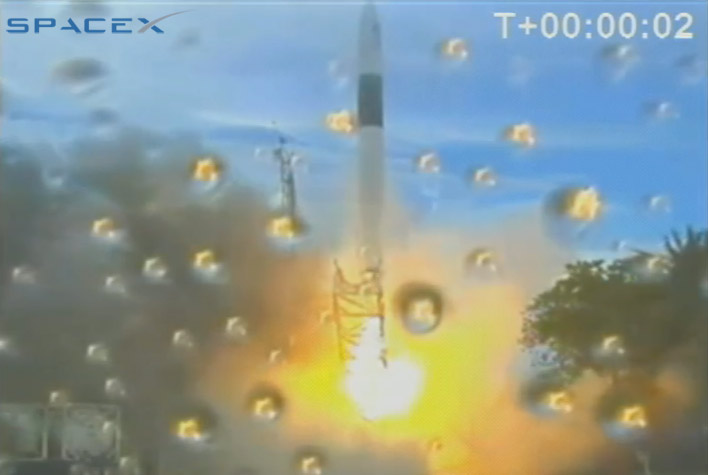SpaceX Successfully Launches Commercial Satellite to Orbit

This story was updated at 10:45 a.m. EDT.
A private spaceflight company launched a Malaysian satellite into orbit using a rocket ofits own design late Monday, marking the firm's first successful commercial space shot.
The Hawthorne,Calif.-based Space Exploration Technologies, Corp. (SpaceX) launched the smallsatellite atop its Falcon 1 rocket, a two-stage booster that made its firstsuccessful test flight last year after three consecutive failures. It wasthe fifth Falcon 1 launch for SpaceX, but its first to successfully haul a functionalEarth-watching satellite into its intended orbit.
The Falcon1 rocket blasted off at about 11:35 p.m. EDT (0335 July 14 GMT) from theU.S. Army's Ronald Reagan Ballistic Defense Test Site on Omelek Island in theKwajalein Atoll, a launch site that sits about 2,500 miles (4,023 km) southwestof Hawaii.
Delayed liftoff
Amalfunction in equipment used to load helium aboard the Falcon 1 rocket pushedthe mission four hours beyond its initial launch target, with stormy weatherdelaying the mission even more. SpaceX initially hoped to launch RazakSAT inApril, but the need to eliminate a vibrationissue between the satellite and its Falcon 1 rocket set the flight backseveral months.
But despitethose lengthy delays, Monday?s launch ultimately reached orbit without a hitch.After jettisoning its first stage as designed, the Falcon 1 booster reached aparking orbit and later restarted its rocket engine to deploy RazakSAT in anorbit that flies high above Earth?s equator.
Get the Space.com Newsletter
Breaking space news, the latest updates on rocket launches, skywatching events and more!
?Secondburn and satellite separation nominal,? SpaceX officials said in an update. ?Falcon1 has successfully deployed RazakSAT into the correct orbit.?
RazakSAT wasbuilt by Malaysia'sAstronautic Technology (M) Sdn. Bhd.(ATSB) to take high-resolution images of Malaysia to aid land management,resource development and conservation, forestry and fish migration studies,SpaceX officials said. The satellite carries a camera that can observe Earth ata panchromatic resolution of 8.2 feet (2.5 meters) and a color resolution ofabout 16.4 feet (5 meters).
The Falcon1 rocket launched several hours after NASA canceled its own launch of the spaceshuttle Endeavour in Florida for thefifth time, this time due to foul weather. The shuttle is slated to launchWednesday to begin a long-delayed construction flight to the InternationalSpace Station.
Falcon rocket family
SpaceX,too, has its eyes on flying to the International Space Station. Founded in 2002by entrepreneur Elon Musk, a co-founder of the electronic payment servicePayPal, SpaceX is aiming to offer low-cost launches to space with its Falcon 1rocket and a larger version called Falcon 9.
The Falcon1 rocket can haul small satellites, like the nearly 400-pound (180-kg)RazakSAT, into low Earth orbit. After three launch failures between 2006 and2008, SpaceX successfully reached orbit with a Falcon 1 rocket last September. Falcon 1 launches currently cost about $8 million per flight, SpaceX officials have said.
The largerFalcon 9, however, is designed to launch SpaceX?sDragon spacecraft, a capsule-based vehicle tapped by NASA as one of two privatelybuilt spacecraft to ferry cargo to and from the International Space Station. NASAawarded SpaceX with a $1.6 billion contract last year to launch 12 unmanned cargoflights to the space station by 2016. The other vehicle, Orbital Sciences Corp.?sCygnus spacecraft, received a $1.9 billion from NASA for eight cargo flights.
SpaceX hasdrawn plans for a free-flying version of Dragon, called DragonLab, for spaceexperiments, as well as a manned version to launch astronauts to and from thespace station. The company plans to launch its first Falcon 9 rocket testflight sometime this year from a seaside pad at the Cape Canaveral Air ForceStation in Florida, SpaceX officials have said.
- New Video - SpaceX?s Vision for Manned Dragon Spaceship
- SpaceX Puts Falcon 9 Rocket Through Launch Pad Paces
- Video - SpaceX's Falcon 1 Rocket Success!
?
Join our Space Forums to keep talking space on the latest missions, night sky and more! And if you have a news tip, correction or comment, let us know at: community@space.com.

Tariq is the Editor-in-Chief of Space.com and joined the team in 2001, first as an intern and staff writer, and later as an editor. He covers human spaceflight, exploration and space science, as well as skywatching and entertainment. He became Space.com's Managing Editor in 2009 and Editor-in-Chief in 2019. Before joining Space.com, Tariq was a staff reporter for The Los Angeles Times covering education and city beats in La Habra, Fullerton and Huntington Beach. In October 2022, Tariq received the Harry Kolcum Award for excellence in space reporting from the National Space Club Florida Committee. He is also an Eagle Scout (yes, he has the Space Exploration merit badge) and went to Space Camp four times as a kid and a fifth time as an adult. He has journalism degrees from the University of Southern California and New York University. You can find Tariq at Space.com and as the co-host to the This Week In Space podcast with space historian Rod Pyle on the TWiT network. To see his latest project, you can follow Tariq on Twitter @tariqjmalik.









